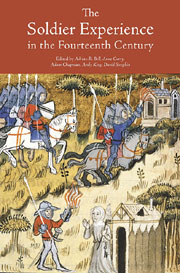Book contents
- Frontmatter
- Contents
- List of Contributors
- List of Abbreviations
- Introduction
- 1 Military Service and the Dynamics of Recruitment in Fourteenth-Century England
- 2 Total War in the Middle Ages? The Contribution of English Landed Society to the Wars of Edward I and Edward II
- 3 A Warlike People? Gentry Enthusiasm for Edward I's Scottish Campaigns, 1296–1307
- 4 Edward I's Centurions: Professional Soldiers in an Era of Militia Armies
- 5 Who's afraid of the Big Bad Bruce? Balliol Scots and ‘English Scots’ during the Second Scottish War of Independence
- 6 Rebels, Uchelwyr and Parvenus: Welsh Knights in the Fourteenth Century
- 7 Breton Soldiers from the Battle of the Thirty (26 March 1351) to Nicopolis (25 September 1396)
- 8 Towards a Rehabilitation of Froissart's Credibility: The Non Fictitious Bascot de Mauléon
- 9 The English Reversal of Fortunes in the 1370s and the Experience of Prisoners of War
- 10 The Soldier, ‘hadde he riden, no man ferre’
- Index
- Warfare in History
10 - The Soldier, ‘hadde he riden, no man ferre’
Published online by Cambridge University Press: 05 February 2013
- Frontmatter
- Contents
- List of Contributors
- List of Abbreviations
- Introduction
- 1 Military Service and the Dynamics of Recruitment in Fourteenth-Century England
- 2 Total War in the Middle Ages? The Contribution of English Landed Society to the Wars of Edward I and Edward II
- 3 A Warlike People? Gentry Enthusiasm for Edward I's Scottish Campaigns, 1296–1307
- 4 Edward I's Centurions: Professional Soldiers in an Era of Militia Armies
- 5 Who's afraid of the Big Bad Bruce? Balliol Scots and ‘English Scots’ during the Second Scottish War of Independence
- 6 Rebels, Uchelwyr and Parvenus: Welsh Knights in the Fourteenth Century
- 7 Breton Soldiers from the Battle of the Thirty (26 March 1351) to Nicopolis (25 September 1396)
- 8 Towards a Rehabilitation of Froissart's Credibility: The Non Fictitious Bascot de Mauléon
- 9 The English Reversal of Fortunes in the 1370s and the Experience of Prisoners of War
- 10 The Soldier, ‘hadde he riden, no man ferre’
- Index
- Warfare in History
Summary
The later fourteenth century is blessed with sources enabling historians to create portrayals of colourful careers in arms. The testimony of deponents before the Court of Chivalry gives the soldiers' own accounts of their activities, while the portrait of the knight in the Canterbury Tales delivers an image of (allegedly) perfect military accomplishments. To this, we can now add the online database produced during the ‘Soldier in Later Medieval England’ project, which provides evidence of both actual and intended service for the English crown. Combining these sources, we can reconstruct a number of detailed case studies of soldiers and where they chose to fight. We can also test the depositions in the Court of Chivalry against the royal records of military service, and consider if the witnesses were braggards, or, by contrast, were modestly understating their level of military service. Finally, can we find out which soldier was ‘best’: who had the longest record of service; who took part in the most varied campaigns; who was the youngest; who was the oldest; and, of course, as the title suggests, taking the line from the description of Chaucer's Knight, who rode the furthest? This essay is limited to a set of case studies, drawing mainly from cases heard before the Court of Chivalry and expanded with further information from the medieval soldier database. Although they cannot be said to form a truly representative sample of the medieval English soldiery, nevertheless, this self-selected sample does indeed allow us to paint a dynamic portrait of what an average, as well as an exceptional, career in arms could involve in the later fourteenth century.
- Type
- Chapter
- Information
- The Soldier Experience in the Fourteenth Centur , pp. 209 - 218Publisher: Boydell & BrewerPrint publication year: 2011



